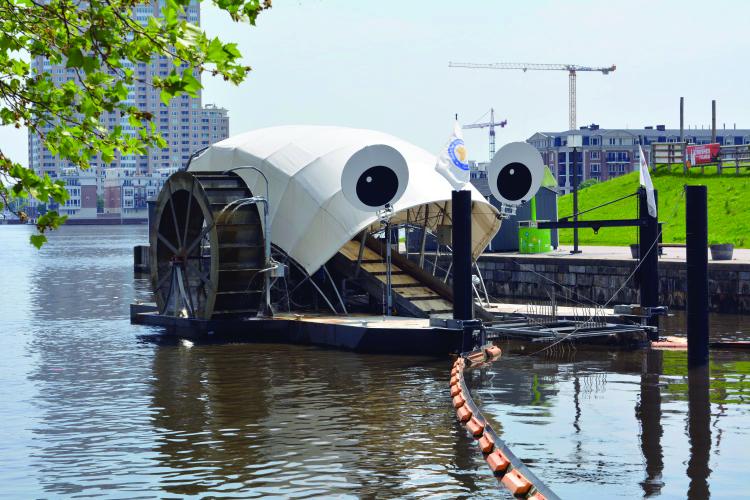Baltimore and Beyond: The Family of Trash Wheels
If your summer sailing plans take you up the Patapsco River (and they should!) to Baltimore’s Inner and Outer Harbors, you may notice a cleaner river than in years past. Baltimore is a beautiful city for sailors, and for the past nine years, its tributaries have been cleaned by a suite of four river-cleaning machines, fondly known as the Trash Wheel Family.

You can glimpse Captain Trash Wheel in the Middle Branch at Masonville Cove. It is the smallest of the four Trash Wheels and is owned by the Maryland Port Administration. After you pass Fort McHenry, keep your eye out for Professor Trash Wheel in Harris Creek in Canton and Mr. Trash Wheel at the mouth of the Jones Falls River. Gwynnda the Good Wheel of the West will be difficult for sailors to view as she is tucked at the mouth of the Gwynn’s Falls, upriver from the Hanover Street Bridge. The latter three wheels are owned by the Waterfront Partnership of Baltimore. All four are built and maintained by Clearwater Mills, LLC. (Full disclosure: my husband John Kellett is the inventor and builder of the Trash Wheels, so we talk a lot of trash around the dinner table!)
Water-wheel-powered trash interceptors or “Trash Wheels” use hydro and solar power to sustainably collect floating debris. River mouth collection has proven to be one of the most effective ways to keep trash out of our oceans. The most effective way is to not have it enter the ocean at all! Floating trash booms that are anchored to the edges of the river guide the trash to a conveyor which is powered by the river current. If the current isn’t strong enough to power the wheel, water pumps driven by solar powered batteries pour water on to the wheel to make it turn. The wheel is geared to a conveyor that moves the trash up into a dumpster on a separate floating barge, which is taken ashore for disposal. The primary pathway for trash entering the rivers is through storm events washing trash in the watershed into the rivers. Collectively the four wheels have removed more than 2500 tons of trash since their installation.
Starvation. Extinction. While these are normally negative topics when it comes to conservation, the goal is to “starve” the Trash Wheels by turning off the pollution tap. This can happen in a variety of ways. On Earth Day 2023 Mr. Trash Wheel celebrated his ninth birthday, so it is a good moment to reflect on the positive outcomes that have come from not only cleaning the river, but from the trash composition data that has driven policy change on the state and local level.
Early on in his life, Mr. Trash Wheel picked up numerous fat “bergs,” gelatinous balls of grease ranging in size from a golf ball to a grapefruit. These bergs travelled downstream through the sewer system, which hadn’t yet undergone its headworks repairs, clogging the pipes up and causing sewage spills. The fat bergs have become extinct with grease-trap monitoring programs for restaurants that have been put in place by the city government.
Mr. Trash Wheel has also been the voice of the polystyrene ban, the plastic bag ban and anti “butt” initiatives. The data collected during storm events not only demonstrates the magnitude of the problems, but also allows for a “before and after” analysis once policy change has been implemented. The amount of polystyrene collected has dropped 80 percent since the ban! Prior to the ban Mr. Trash Wheel collected more than 100,000 foam containers per year; so we can see that legislative change has reduced the amount of single-use plastics that harm our rivers, bays, and oceans. While the plastic bag ban is relatively new, there is already evidence that the volume of bags has dramatically decreased.
If you are interested in updated data, the Waterfront Partnership maintains a data dashboard at mrtrashwheel.com. The newest Trash Wheel, “Wanda” resides in the Juan Diaz River in Panamá City, Panamá. She is one of eight global river capture devices, funded by the Clean Currents Coalition, working to enact change in Panamá and around the world. Find the cumulative data dashboard at cleancurrentscoalition.org/coalition-projects.
The eight projects have collectively removed over one million kilograms of trash and floating debris from rivers. While you can’t see Wanda from the Pacific side of the canal as she is upstream from Panamá Bay, you can visit her as soon as the new on site education center has been completed.
While intervention systems aren’t the solution to the plastics crisis, they are powerful tools to clean rivers and drive behavior and policy change. Hopefully, sailors will start to see the difference!
By Pamela Tenner Kellett




